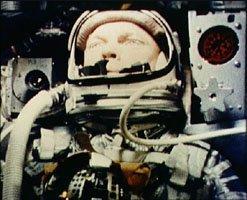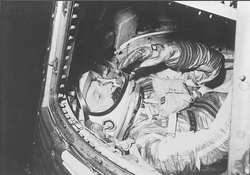First American to Orbit; Oldest Astronaut Remembers
 Annie Glenn watched her husband, a Marine Corps
combat veteran, leave the ground for some countless time on the
morning of February 20, 1962 (right). It was a short flight of just
four hours, 55 minutes, but it would be the most significant flight
he would ever take. In truth, it was the most important flight in
history. It opened the doors of hope for the American people and
made Col. John Glenn a household name.
Annie Glenn watched her husband, a Marine Corps
combat veteran, leave the ground for some countless time on the
morning of February 20, 1962 (right). It was a short flight of just
four hours, 55 minutes, but it would be the most significant flight
he would ever take. In truth, it was the most important flight in
history. It opened the doors of hope for the American people and
made Col. John Glenn a household name.
Glenn had realized the American dream of reaching for the stars
when he became the first American to orbit the Earth, orbiting
three times on that flight. For an America caught in the grips of
the Cold War, Glenn became a reassuring symbol of hope. He offered
a glimpse into the new future and made a strong statement about
America's determination not to be left out of the space race.
Glenn's storied history began when the 20-year-old was heading
to church to hear his fiancée Annie's music recital. That's
when the news came over the radio: Pearl Harbor had been
attacked.
"She and I had planned to be married after we were out of
college," Glenn said. "But we sat and talked that evening and
decided my responsibility was to go, and I dropped out of school
... and went into military flight training and was in the Marine
Corps for the next 23 years."
Glenn became a fighter pilot and flew 59 combat missions in
World War II and another 63 during the Korean War. After the war,
he became a test pilot, and in 1957 set a transcontinental speed
record from Los Angeles to New York, taking his plane across the
country in three hours and 23 minutes. This was the first
transcontinental flight to average supersonic speed.
 Then he shifted his sights to NASA, and from more
than 100 applicants, he was selected as one of the first seven
astronauts in the race for space. According to Glenn, they were all
highly motivated. "Each of us thought we deserved to be number one
in whatever was going to happen," recalled Glenn.
Then he shifted his sights to NASA, and from more
than 100 applicants, he was selected as one of the first seven
astronauts in the race for space. According to Glenn, they were all
highly motivated. "Each of us thought we deserved to be number one
in whatever was going to happen," recalled Glenn.
Glenn was the third American in space, but the first to orbit
the Earth. The historic flight made Glenn such a potent icon that
President Kennedy did not want to risk losing him and Glenn was
grounded from future space flights. Unable to fly again, Glenn left
NASA two years later, after his retirement from the Marine Corps,
and entered the private industry.
Still, a desire to serve mankind existed in Glenn and he ran for
the U.S. Senate from Ohio. He won and served for the next 24
years.
The wanderlust of space travel never left him though, and he
began pleading his case to NASA to return him to space. He
contended that studies on the effects of space on aging could be
done on him, and 36 years after his inaugural flight, NASA agreed.
"In our lifetime, we've lived through starting this whole thing,
and now we are using it for the benefit of everybody right here.
It's hard to believe that in my own lifetime the different things
I've been able to participate in," mused Glenn before that flight.
"I want to soak up every bit of experience I can on this."
 October 29, 1998, Glenn, at 77, set the record
again, becoming the oldest man in space, though to his dismay, he
was not allowed to make a space walk. "NASA wouldn't let me do that
because they were afraid at my age ... I might wander off
someplace," Glenn said jovially after his second historic
flight.
October 29, 1998, Glenn, at 77, set the record
again, becoming the oldest man in space, though to his dismay, he
was not allowed to make a space walk. "NASA wouldn't let me do that
because they were afraid at my age ... I might wander off
someplace," Glenn said jovially after his second historic
flight.
These days, he still isn't settling into retirement. He's
pushing reform aimed at increasing math and science education in
grade schools, but he still isn't comfortable with the title of
American hero. "I don't have the foggiest idea what heroism means,"
he said last year during one such education speech. "The last thing
I think about when I get up in the morning and pull my socks on is
"I'd better put my hero socks on today.'"
[Thanks to Marine Sgt. A. Lyn Bell --ed.]
 ANN's Daily Aero-Term (04.14.24): Maximum Authorized Altitude
ANN's Daily Aero-Term (04.14.24): Maximum Authorized Altitude ANN's Daily Aero-Linx (04.14.24)
ANN's Daily Aero-Linx (04.14.24) Classic Aero-TV: 'We're Surviving'-- Kyle Franklin Describes Airshow Life 2013
Classic Aero-TV: 'We're Surviving'-- Kyle Franklin Describes Airshow Life 2013 Aero-News: Quote of the Day (04.14.24)
Aero-News: Quote of the Day (04.14.24) Airborne 04.09.24: SnF24!, Piper-DeltaHawk!, Fisher Update, Junkers
Airborne 04.09.24: SnF24!, Piper-DeltaHawk!, Fisher Update, Junkers





